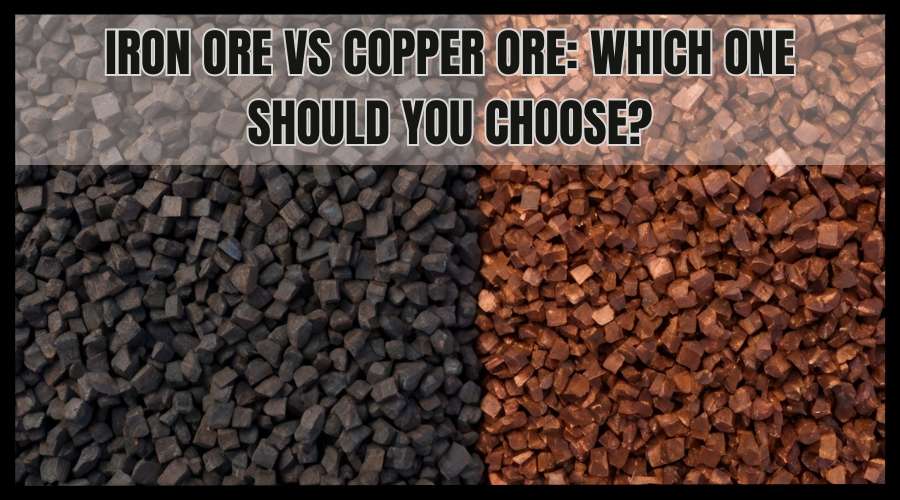
The mining world offers many materials, each with unique properties and uses. Two of the most significant and widely utilized ores are iron ore and copper ore. But when it comes to choosing between the two, how do you determine which one is more beneficial for your needs? This article delves into the characteristics, uses, and economic implications of both iron ore and copper ore to help you make an informed decision.
Iron ore and copper ore are essential raw materials for various industries. Iron ore is primarily used in steel production, vital for construction, manufacturing, and infrastructure. On the other hand, copper ore is a key component in electrical wiring, electronics, and various metal alloys. Understanding their properties and applications is crucial in determining which ore suits your needs.
Iron ore primarily consists of iron oxides, such as hematite (Fe2O3) and magnetite (Fe3O4). These ores are usually rich in iron, making them ideal for steel production. Iron ore is known for its high tensile strength, durability, and magnetic properties, essential for various industrial applications.
Copper ore contains copper minerals like chalcopyrite (CuFeS2), bornite (Cu5FeS4), and malachite (Cu2CO3(OH)2). Copper is renowned for its excellent electrical conductivity, corrosion resistance, and malleability, which make it indispensable in the electrical engineering, plumbing, and renewable energy sectors.
The extraction of iron ore involves mining, crushing, and beneficiation. Depending on the ore's location, mining techniques such as open-pit and underground mining are employed. The extracted ore undergoes crushing to break it into smaller pieces, followed by beneficiation to remove impurities and increase iron concentration. The final product is then sent to blast furnaces for smelting.
Copper ore extraction involves mining, crushing, and beneficiation, but the processing techniques differ. After mining, the ore is crushed and ground into a fine powder. The powder undergoes flotation, where chemicals are added to separate copper minerals from the rest. The concentrate is then smelted and refined to produce pure copper.
· Steel Production: Iron ore is the primary raw material for steel manufacturing, accounting for about 98% of global iron ore production.
· Construction: Steel derived from iron ore is used in building structures, bridges, and infrastructure projects.
· Automotive Industry: Steel is crucial in manufacturing car bodies, engines, and various automotive components.
· Machinery: Heavy machinery and industrial equipment rely on steel for their construction.
· Electrical Wiring: Copper's excellent conductivity makes it ideal for electrical wiring and cables.
· Electronics: Copper is used in circuit boards, connectors, and various electronic devices.
· Plumbing: Copper pipes are preferred for their corrosion resistance and durability.
· Renewable Energy: Copper is a key component in solar panels, wind turbines, and other renewable energy systems.
Industrial growth and infrastructure development drive the demand for iron ore and copper ore, respectively. However, the market dynamics differ for each ore.
The steel industry's demand influences iron ore prices. Countries like China, the largest steel producer, significantly impact iron ore prices. The market is highly competitive, with major players like Australia and Brazil dominating production.
The electrical and electronics industry drives copper ore prices. Copper demand has surged with the rise of renewable energy and electric vehicles. Major producers include Chile, Peru, and the United States.
Iron ore mining has a significant environmental impact. Deforestation, soil erosion, and water pollution are common issues associated with iron ore extraction. The steelmaking process also contributes to greenhouse gas emissions.
Copper ore mining also poses environmental challenges. Habitat destruction, water contamination, and air pollution are major concerns. However, copper's recyclability helps mitigate some environmental impacts, making it a more sustainable option.
Steel derived from iron ore is highly recyclable, which reduces the need for new ore extraction. Recycling steel conserves energy, reduces emissions, and minimizes waste.
Copper is one of the most recyclable materials, retaining its properties through multiple recycling processes. Recycling copper saves energy, reduces carbon footprint, and conserves natural resources.
Countries with significant iron ore reserves include Australia, Brazil, Russia, and China. These reserves ensure a steady supply of iron ore for industrial use.
Chile, Peru, and the United States hold substantial copper reserves. The availability of these reserves supports the growing demand for copper in various industries.
The iron ore industry is expected to grow with increasing urbanization and industrialization. Innovations in mining technology and sustainable practices are likely to shape the future of iron ore production.
The copper ore industry is poised for growth due to the rising demand for renewable energy and electric vehicles. Advancements in mining techniques and recycling processes will play a crucial role in meeting future copper demands.
Choosing between iron ore and copper ore depends on your specific needs and industry requirements. Iron ore is indispensable for steel production and construction, offering high strength and durability. With its excellent conductivity and corrosion resistance, copper ore is essential for electrical wiring, electronics, and renewable energy. Both ores have significant economic value and environmental impacts, but their recyclability contributes to sustainability. Understanding their properties, applications, and market dynamics will help you make an informed decision that aligns with your goals and priorities.
In conclusion, iron ore and copper ore have unique advantages and are crucial to various industries. By weighing their properties, uses, and economic implications, you can determine which ore best suits your needs and contributes to your success.